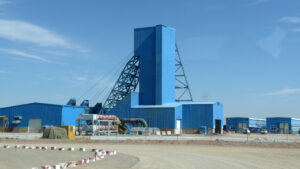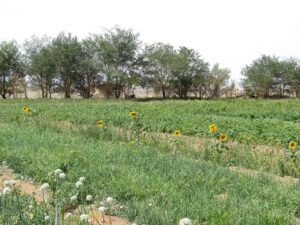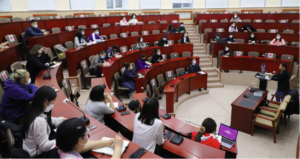
Mining
Mongolia has substantial natural resources and minerals, which promise an unprecedented growth potential. Mongolia as a one of the world’s leading mineral resources has over 8,000 occurrences and 80 types of minerals and metals in the 1170 minefield and high prospective for copper, base metals, gold, coal and uranium. Thus, the importance of mining to the Mongolian economy cannot be overstated, as it has been a key driver of economic growth. The mining industry still remains the largest contributor to the Mongolian economy. The country is home to several large-scale mining operations, including the Oyu Tolgoi copper and gold mine, which is jointly owned by the Mongolian government and global mining giant Rio Tinto. The mining industry has also attracted investments from other major players worldwide, including Chinese, Canadian, and European ones. In April 2022, the government launched its so-called Revival Strategy which includes future plans (Vision 2050) focusing on a revamp of six areas that need “recovery”: port, energy, industrial, urban and rural, green growth, and State productivity. Mongolia has been identified by the International Monetary Fund (IMF) as one of the 29 developing countries that are rich in natural resources, and the exploration of coal and copper deposits is generating a significant amount of extra revenue. Mongolia primarily mines coal, copper, and gold.
Mongolia has invited Indian companies to mine its precious metals and non-precious metals in June 2023. Indian companies can set up semiconductor manufacturing plants in Mongolia by making use of the available raw material in that country and then export these semiconductors to India for assembly into final electronic goods. India’s Steel Ministry has reached out to Mongolia as it looks to start work on creating logistics support and explore possible investments for bringing in coking coal from the Central Asian nation. A joint working group of Indian and Mongolian government officials is “being activated” to look into the issue as of November 2023.

Agriculture
There exists broad opportunities and potentials to develop traditional agriculture sector in Mongolia. The sector is one of the priority sectors to the country’s economy and cultural heritage, food and agriculture production compounds 13% of the GDP of Mongolia, 35% of total Mongolian work force, and 73.6% of Mongolian land is agricultural land. There is a great potential for exports of high value-added industrial products based on meat, cashmere, yak hair, sheep and camel wool and over the past decade, the agriculture sector-one of Mongolia’s oldest industries has remained integral to the country’s long-term development strategy. According to recent analysis, about 60 percent of Mongolian cultivated area is low in nitrogen and potassium which is easy to use in plants, and 34.7 percent low in phosphorus concentrations, respectively. Thus, there are opportunities to intensify and further develop crop farming by systematically using mineral fertilizers based on soil test results and physiological context of crops, and by extensively utilizing nutrients and biofertilizers made by local natural and farming resources.
The Indian Government has been realizing ‘Operation Flood’, the world’s biggest dairy development program since 1970, coherently developing all the stages from rural small farmers to consumers in the cities and creating sustainable supply system. To introduce the practice in Mongolia, the countries came to a decision to collaborate and launch the project ‘Mongolia-India joint dairy development program’ in 2020.

Education
Mongolia continues to adhere to the Soviet model of 10 years of school education of which 8 are compulsory, although this is being gradually extended in the direction of the European model. There is also an extensive pre-school education system, where children may enroll from age 3 onwards.Some Mongolian students study abroad on scholarships funded by host country governments or institutions. According to the Mongolian government, in 2019, 1,500 Mongolian students enrolled in institutions in other countries based on agreements between the Mongolian and host country governments. These agreements range from bilateral scholarships that reduce tuition fees for Mongolian students, to pathways that open opportunities for Mongolian students to study in specific countries and institutions.
In a move that underscores the expanding educational and technological partnership between India and Mongolia, officials from both countries have signed a contract to initiate the construction of the India-Mongolia Friendship Secondary School. The deal was formalized in Ulaanbaatar during the official visit of Secretary (East) in India’s Ministry of External Affairs Saurabh Kumar on September 12, 2023.The construction of the India-Mongolia Friendship Secondary School marks a novel approach to international cooperation. Unlike more conventional realms of diplomatic exchange such as defense and trade, this educational initiative symbolizes a mutual recognition of the importance of knowledge and skill development for the future.

Tourism and Spirituality Sector
Mongolia has its own unique culture, customs, and way of life that appears in its tourism sector. Mongolia has expanse, broad lands with rich history and cultural landscape. d. Mongolia is the most sparsely populated country in the world. Additionally, about 40% of its people are nomadic or semi-nomadic. The mightiness resources to advertisement local and foreign tourists and develop tourisms, are Mongolian nomadic cultures, history and wonderful natural therefore the number of travellers to Mongolia is being advanced grows.
India and Mongolia have interacted since antiquity through the vehicle of Buddhism throughout the history. Some Indian & Mongolian historians have conjectured about migration of some tribes from Kangra kingdom to Mongolian territory 10000 years ago. In recent times, late Ambassador Bakula Rimpoche during his 10 years’ tenure in Mongolia from 1990-2000 contributed immensely to consolidating this legacy of Buddhist connection with India and was instrumental in reviving 100s of Buddhist monasteries including Pethub Monastery in Mongolia. Likewise, several recent Mongolian scholars like Prof. Ganden darama too have pitched in furthering the cultural heritage common to India and Mongolia
Oil and Gas
Mongolia’s first oil refinery, built and funded with Indian assistance, will be completed by 2025. The first stage of Mongol Oil Refinery, built with a $1.2 billion Indian soft loan, will be completed at the end of 2023.The development comes with strategic implications as Mongolia is entirely dependent on Russia for its energy imports. In addition, it will generate employment opportunities, bolster the growth of nearby small industries, and contribute to Mongolia’s economic development in the future. In addition, MEIL will also build utility and offsite facilities and other enabling facilities. This refinery project is a government-to-government (G2G) initiative. Upon completion, the refinery is expected to produce 1.5 million tonnes of crude oil annually, catering to Mongolia’s domestic demand for gasoline, diesel, aviation fuel, and LPG.
The Embassy of India in collaboration with the Ministry of Mining & Heavy Industry of Mongolia, the Mongol Refinery State Owned LLC and Engineers India Limited (EIL) organised a joint India-Mongolia Oil and Gas Exhibition in Ulaanbaatar City at Buyant –Ukhaa, Sport Complex in 2019 in connection with the first ever 1.5 MMTPA refinery being set up in Mongolia. More than 35 reputed Indian Companies in Oil and Gas sector participated in the Exhibition.
Infrastructure
Mongolia has undertaken reforms in its investment regulatory framework to attract foreign direct investments, increase transparency and put domestic and international investors on more equal footing. There has been almost no private sector participation in infrastructure projects, even in the form of public-private partnerships (PPPs), and the state continues to play an outsized role in the energy, transport and water sectors. Mongolia’s railway network currently connects the country to Russia and China, its two neighbours. However, the country is looking to expand its network to connect with other countries in the region. Mongolia’s railway expansion plans include the construction of new lines, as well as upgrading the existing ones. The country is also looking to develop its infrastructure for freight transportation, including the establishment of logistics centers. Mongolia’s construction sector has been rapidly growing in response to the demand for infrastructure and housing development. In 2021, the size of the construction market in Mongolia was assessed at US$2.2 billion. It is predicted to experience an Average Annual Growth Rate (AAGR) of over 4 percent between the years 2023 to 2026. In addition, the government has implemented several policies to encourage the growth of the sector, such as the country’s Investment Law, which provides tax incentives for construction projects.
India has some experience with building railway projects in other countries. Rail India Technical and Economic Services (RITES), a public sector enterprise set up in 1974, provides infrastructure study, rolling stock design, equipment design and a suite of engineering services to other countries. Mongolia’s Deputy Prime Minister and Minister of Road and Transport Development, Amarjargal Gansukh, held a meeting in 2023 with Indian Ambassador to Mongolia, M.P. Singh, to discuss potential collaborations between the two countries. Mongolia seeks Indian expertise to improve rail network. During the meeting, Gansukh expressed Mongolia’s interest in working with Indian companies to enhance its rail network. Mongolia is seeking Indian expertise and investment to develop its rail infrastructure, including upgrading and expanding the existing network.
Films and Shooting
Mongolian cinema has developed rapidly with a high level of professionalism and the emergence of strong talent specializing in the art of filmmaking. Over the last five years, the Mongolian film industry has averaged 80 studio productions, employing hundreds of film industry employees. The country now has many major movie theatres and screening venues with 40 new films released per year (17 during the COVID-19 pandemic); and nearly 2 million potential moviegoers. The Mongolian National Film Council implements the Law on Promotion of Cinematography and focuses on increasing the film production capacity of Mongolian artists, developing their professional skills, supporting cooperation between Mongolian and foreign filmmakers, and promoting Mongolian cinema at the international level. They provide permission for foreign filmmakers to film in Mongolia, receive and resolve requests for reimbursement of film production costs, and provide all necessary information. The core of MNFC’s mission is to develop a vibrant and creative film industry in Mongolia. The Mongolian government has recently provided unprecedented programs to support and encourage both domestic and global film producers who base their projects in Mongolia. Global producers can apply for incentives of up to 45%, which come in the form of cash rebates, and are among the most competitive in the world (30% location incentive, 10% cultural incentive and 5% foreign talent reimbursement).
Hindi films are fairly popular in Mongolia. The serial Mahabharata, dubbed in Mongolian, has been telecast on Ulaanbaatar TV. A photographic exhibition entitled “Path of Compassion”, another one titled ‘Amrita Shergil Revisited’ and an exhibition of 540 Indian paintings based on a private collection have been organized in Mongolia. In March 2018Mongolian film festival was celebrated in Kolkata, where Mongolian films were shown. Hindi film festival was organized in Ulaanbaatar city from 27-29 March 2019 in which two Hindi movies, Neerja and Dangal, were screened.
Medical Tourism
Medical tourism from Mongolia has a considerable impact on the Mongolian economy and health system, creating a need to better understand the scope of this practice and practical steps for addressing demand for it. The increasing popularity of medical treatment in India among Mongolian patients highlights the country’s commendable healthcare infrastructure, affordability, and expertise in specialized treatments. With a history of strong Indo-Mongolian relations, this trend opens doors for future cooperation in knowledge exchange, joint research, and telemedicine. As India continues to provide quality healthcare services to patients from Mongolia and around the world, the bond between the two nations strengthens, creating a win-win situation for both the patients and the healthcare industry as a whole. In recent years, India has witnessed a remarkable growth in medical tourism from Mongolia, with a staggering increase of 80% in the number of patients traveling for treatment. This surge can be attributed to the state-of-the-art infrastructure, skilled medical professionals, and advanced technology available in Indian hospitals. A study conducted by the Ministry of Health in Mongolia revealed that a significant percentage of patients (around 40%) who opt for medical treatment abroad choose India as their preferred destination, highlighting the trust and confidence they have in the Indian healthcare system. India can leverage its expertise in telemedicine to provide remote healthcare services to Mongolian patients. This approach will not only reduce travel costs but also provide access to expert opinions without physically visiting India.
Information Technology (IT)
Over the last five years Mongolian demand for information technology (IT) goods and services has boomed as Mongolia’s young and adaptable population has embraced IT products for personal and professional uses. The government recognizes the important role of the private sector and expresses their support in the following interventions: use ICT for increasing the competitiveness of national industry and services, support start-up businesses in ICT, activate domestic ICT market by promoting and intensifying ICT consumption by the government.
The sector has the potential to attract a considerable amount of FDI, to facilitate new activity, faster and better services. With the high mobile penetration rate, subscriber growth is widely expected to slow or plateau in the coming years.The government has taken on a key role in this area, introducing a number of large-scale, long-term development plans aimed at ensuring steady improvements in both the reach and the quality of national telecoms networks. The government is fully behind the blossoming IT industry. In 2018, it launched the Hub Innovation Center, the nation’s first facility that directly supports startups

